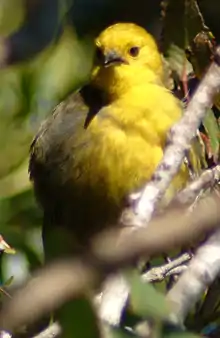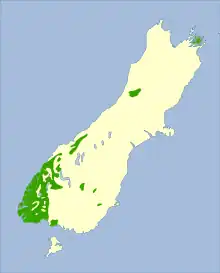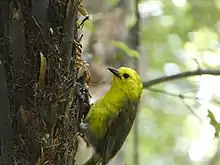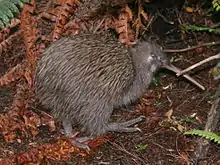Yellowhead (bird)
The yellowhead or mohua (Mohoua ochrocephala) is a small insectivorous passerine bird endemic to the South Island of New Zealand. Once a common forest bird, its numbers declined drastically after the introduction of rats and stoats, and it is now near threatened.
| Yellowhead | |
|---|---|
 | |
| Yellowhead or mohua | |
| Scientific classification | |
| Domain: | Eukaryota |
| Kingdom: | Animalia |
| Phylum: | Chordata |
| Clade: | Dinosauria |
| Class: | Aves |
| Order: | Passeriformes |
| Family: | Mohouidae |
| Genus: | Mohoua |
| Species: | M. ochrocephala |
| Binomial name | |
| Mohoua ochrocephala (Gmelin, JF, 1789) | |
 | |
Taxonomy
The yellowhead was formally described in 1789 by the German naturalist Johann Friedrich Gmelin in his revised and expanded edition of Carl Linnaeus's Systema Naturae. He placed it with the flycatchers in the genus Muscicapa and coined the binomial name Muscicapa ochrocephala.[2] The specific epithet is derived from the Ancient Greek ōkhros meaning "pale yellow" and -kephalos meaning "-headed".[3] Gmelin based his account on the "yellow-headed fly-catcher" that had been described in 1783 by the English ornithologist John Latham in his book A General Synopsis of Birds.[4] The naturalist Joseph Banks had provided Latham with a watercolour painting of the bird by Georg Forster who had accompanied James Cook on his second voyage to the Pacific Ocean. The inscription on the painting includes the year 1774 and the location "Queen Charlotte's Sound". Queen Charlotte Sound is on the north coast of the South Island of New Zealand. This picture is the holotype for the species and is in the collection of the Natural History Museum in London.[5] The yellowhead in now one of three species placed in the genus Mohoua that was introduced in 1837 by the French naturalist René Lesson.[6] The species is monotypic: no subspecies are recognised.[6]
The yellowhead was known in the 19th century as the "bush canary", after its trilling song.[7] It is also known as mohua from the Māori mōhoua.[8] Recent classification places this species and its close relative, the whitehead, in the family Mohouidae.
Distribution and habitat
The yellowhead and the whitehead have allopatric distributions as, conversely, the latter is found only in the North Island and several small islands surrounding it. Although abundant in the 19th century, particularly in southern beech forests on the South Island and Stewart Island / Rakiura, mohua declined dramatically in the early 20th century due to the introduction of black rats and mustelids; nesting in tree holes makes them more vulnerable to predators.[9]
Today they have vanished from almost all of the South Island's forests and exist in less than 5% of their original range.[9][7] On mainland South Island there is currently a small population of mohua in the Marlborough Sounds and around Arthur's Pass,[9] but a quarter of the population lives in the beech forests of the Catlins. The mohua number about 5000.[7]
Conservation
In New Zealand, mohua have the status of a protected threatened endemic species. Conservation efforts are being made to ensure its survival and mohua populations have been established on several predator-free offshore islands, such as Breaksea Island in Fiordland and Ulva Island. Birds have been captive-bred at Orana Park in Christchurch.[9]
In 2003, 39 mohua were translocated from Breaksea Island to predator-free Codfish Island / Whenua Hou, and more were introduced to Whenua Hōu from the Catlins in 2018, increasing the island's population to about 1000.[10] More releases are planned to islands in Fiordland.[10]

Pest control efforts by the Department of Conservation have managed to stabilise some mainland mohua populations. For example, where biodegradable 1080 poison was used to control rats in the Dart valley, there was a more than 80% survival rate, compared with just 10% in untreated areas.[11] The population of mohua in the Landsborough valley has increased four-fold since 1998, thanks to an intensive programme of pest control, including aerial 1080. The population is now strong enough for birds to be transferred out to establish a new population on Resolution Island. Similar aerial 1080 operations in the Catlins[12] and the Hurunui,[13] Hawdon and Eglinton valleys[14] have had equally encouraging results. DOC and TBfree New Zealand noted in March 2014 that there was a significant repopulation in the Catlins of other avian species, including bellbird and tomtit due to the reduction of predators.[15]
Popular culture
Since the redesign of New Zealand's currency in 1991 a yellowhead has appeared on the reverse side of the New Zealand $100 note.[7]
References
- BirdLife International (2022). "Mohoua ochrocephala". IUCN Red List of Threatened Species. 2022: e.T22705397A209465053. Retrieved 12 December 2022.
- Gmelin, Johann Friedrich (1789). Systema naturae per regna tria naturae : secundum classes, ordines, genera, species, cum characteribus, differentiis, synonymis, locis (in Latin). Vol. 1, Part 2 (13th ed.). Lipsiae [Leipzig]: Georg. Emanuel. Beer. p. 944.
- Jobling, James A. (2010). The Helm Dictionary of Scientific Bird Names. London: Christopher Helm. p. 279. ISBN 978-1-4081-2501-4.
- Latham, John (1783). A General Synopsis of Birds. Vol. 2, Part 1. London: Printed for Leigh and Sotheby. p. 342, No. 37.
- Lysaght, Averil (1959). "Some eighteenth century bird paintings in the library of Sir Joseph Banks (1743-1820)". Bulletin of the British Museum (Natural History), Historical Series. 1 (6): 251-371 [308, No. 157].
- Gill, Frank; Donsker, David; Rasmussen, Pamela, eds. (January 2023). "Whiteheads, sittellas, Ploughbill, Australo-Papuan bellbirds, Shriketit, whistlers". IOC World Bird List Version 13.1. International Ornithologists' Union. Retrieved 29 March 2023.
- Graves, Andrea (July–August 2016). "Mōhua: the story of the bird on our $100 note". New Zealand Geographic. 140.
- "Yellowhead | New Zealand Birds Online". nzbirdsonline.org.nz. Retrieved 15 June 2019.
- Quinlivan, Mark; Logan, Mel (8 May 2019). "How our native mōhua bird went from 'rare' to 'common' in just 21 years". Newshub. Retrieved 23 July 2020.
- "Genetic boost for threatened mōhua living on Whenua Hōu". Stuff. 24 October 2018. Retrieved 23 July 2020.
- Making mohua safe at Lake Wakatipu
- TVNZ: 1080 poison pays off for endangered NZ bird
- Department of Conservation
- 1080: The Facts: 1080 helping mohua
- Department of Conservation (7 March 2014). "Catlins mōhua increase after pest control". www.doc.govt.nz. Retrieved 23 July 2020.
Literature
- Heather, Barrie D; Robertson, Hugh A & Onley, Derek (2000). The field guide to the birds of New Zealand. Viking: Printing Press. ISBN 0-670-89370-6.
External links
- Mōhua Charitable Trust
- "Mohua (Yellowhead)". Department of Conservation Te Papa Atawhai. Retrieved 18 May 2020.

